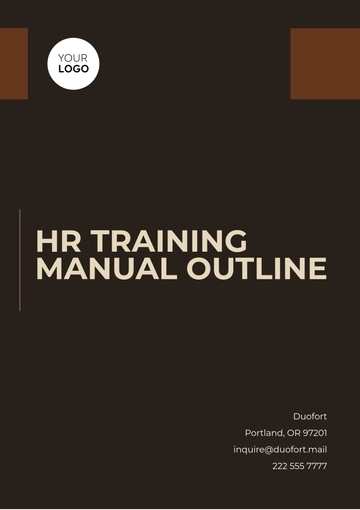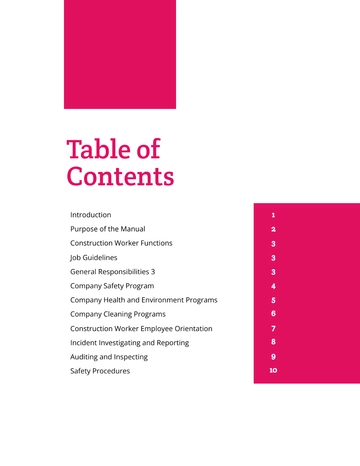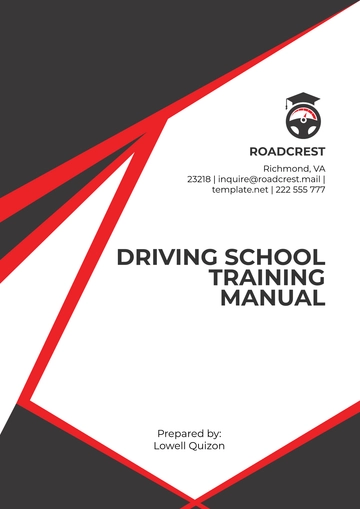Free Logistics and Supply Chain Training Manual

Prepared by: [Your Company Name]
Date: [Date]
I. Introduction
This Logistics and Supply Chain Training Manual serves as a comprehensive resource for professionals in logistics and supply chain management. It includes step-by-step guidelines, detailed procedures, and industry best practices aimed at enhancing the efficiency, effectiveness, and reliability of logistics and supply chain operations. This manual is designed for new hires, seasoned employees, and managers looking to standardize and optimize processes across all levels.
In today's global economy, efficient logistics and supply chain management are key to staying competitive. This manual will help your organization streamline operations, reduce costs, and ensure customer satisfaction through best practices in inventory management, transportation, procurement, and distribution.
II. Roles and Responsibilities
Understanding and defining roles within the logistics and supply chain framework is essential for seamless operations. Each role has distinct responsibilities that contribute to the overall success of the supply chain. Below is a detailed overview of key positions within the team.
Supply Chain Manager
Oversees the entire supply chain from raw material sourcing to final delivery.
Manages relationships with suppliers and vendors.
Ensures optimal performance and coordinates between departments to maximize efficiency and reduce costs.
Logistics Coordinator
Manages transportation of goods, including scheduling shipments and overseeing carrier performance.
Ensures deliveries are on time and meet quality standards.
Handles both domestic and international logistics.
Inventory Specialist
Monitors stock levels and conducts regular inventory audits.
Optimizes inventory to avoid stockouts or overstock.
Implements strategies like Just-In-Time (JIT) inventory management.
Procurement Officer
Sources suppliers and negotiates contracts.
Ensures goods and services are procured at the best possible price without sacrificing quality.
Maintains supplier relationships and ensures procurement aligns with company standards.
Warehouse Supervisor
Oversees warehouse operations, including receiving, storing, and dispatching goods.
Ensures efficient use of space and compliance with safety standards.
Prepares orders for timely delivery.
Distribution Manager
Manages the distribution process from warehouse to end customer.
Focuses on strategic warehousing, order fulfillment, and distribution channels to ensure smooth and timely delivery.
Customer Service Manager
Manages customer relationships and handles inquiries related to shipments.
Ensures customer complaints are resolved quickly and effectively.
Maintains high levels of customer satisfaction.
III. Processes and Procedures
To ensure efficiency, every step of the logistics and supply chain process must be followed with precision. Below are critical processes and procedures essential for maintaining smooth operations:
A. Inventory Management
Stock Audits: Conduct regular stock audits to verify inventory accuracy and identify discrepancies. This can be done through cycle counts or full physical inventory checks.
Just-In-Time (JIT) Inventory: Implement JIT inventory practices to minimize storage costs and reduce waste. Ensure that goods are delivered just as they are needed in the production process.
ABC Classification: Prioritize inventory based on value. ‘A’ items represent high-value products that require tight control, while ‘C’ items are low-cost and require less oversight. Optimize inventory management by focusing on the most valuable items.
B. Transportation Management
Route Optimization: Use tools like Transport Management Systems (TMS) to optimize delivery routes for maximum efficiency, minimizing delivery time and fuel costs.
Fleet Management: Monitor the performance of your transportation fleet. Ensure regular vehicle maintenance to avoid breakdowns and delays. Track driver performance to maintain delivery schedules.
Carrier Contracts: Negotiate and manage contracts with carriers, ensuring cost-effective and reliable service. Regularly review carrier performance and rates.
C. Procurement
Supplier Relationships: Develop and maintain long-term relationships with reliable suppliers. Build strategic partnerships to ensure consistent supply and competitive pricing.
Competitive Bidding: Implement a formal bidding process to ensure that your organization secures the best prices for goods and services. This process encourages competition and ensures fairness.
Contract Management: Ensure all contracts are comprehensive, including terms for pricing, quality standards, and delivery schedules. Manage contracts to avoid disputes and ensure compliance with agreed terms.
D. Distribution Management
Strategic Warehousing: Select warehouse locations that optimize distribution to key markets. Ensure warehouses are organized and staffed appropriately to meet demand.
Order Fulfillment: Implement processes that ensure orders are picked, packed, and shipped promptly and accurately. Monitor fulfillment times and adjust staffing and procedures to ensure customer expectations are met.
Customer Satisfaction: Continuously monitor delivery performance and customer feedback. Address any distribution issues that could negatively impact customer satisfaction, such as late deliveries or incorrect shipments.
IV. Best Practices
Here are industry best practices to ensure smooth logistics and supply chain operations:
Vendor Relationships: Foster strong, long-term relationships with vendors and suppliers. A healthy relationship can lead to better terms, early access to new products, and support during supply chain disruptions.
Data Analytics: Use data analytics to predict demand trends and manage inventory. By anticipating trends, businesses can avoid overstocking or understocking.
Risk Management: Establish a robust risk management framework. Regularly review risks related to suppliers, transportation, inventory, and regulatory changes. Prepare contingency plans for issues such as natural disasters, strikes, or economic downturns.
Ongoing Training: Continuously train employees on new technologies, processes, and regulations to keep the supply chain agile and compliant.
V. Compliance and Safety
Ensuring compliance with industry standards and maintaining workplace safety are non-negotiable aspects of supply chain management. Here’s how to keep your operations compliant and safe:
Shipping Regulations: Stay up-to-date with local and international shipping regulations, including customs duties, import/export laws, and environmental guidelines.
Workplace Safety: Enforce strict safety standards in warehouses, transportation, and distribution centers. Regularly conduct safety training for all employees and ensure that equipment is well-maintained and used properly.
Compliance Monitoring: Implement systems to monitor compliance with both industry and government regulations. Stay informed of regulatory changes that could impact supply chain operations, and adjust procedures accordingly.
VI. Tools and Software
To streamline logistics and supply chain operations, leveraging technology is essential. Below are key tools that can enhance efficiency:
Enterprise Resource Planning (ERP) Systems: ERPs integrate various business operations, including procurement, inventory management, and order processing, offering real-time data and improving decision-making.
Warehouse Management Systems (WMS): WMS software helps optimize inventory tracking, order picking, and warehouse layout, improving the efficiency of your warehouse operations.
Transport Management Systems (TMS): TMS tools are used to optimize route planning, monitor fleet performance, and improve the overall shipping process by reducing costs and delivery times.
Demand Forecasting Software: Use predictive analytics software to anticipate customer demand and adjust supply chain operations accordingly, helping to minimize surplus inventory or stockouts.
VII. Troubleshooting
When issues arise, it's essential to troubleshoot quickly to maintain operational efficiency. Here are some common issues and their solutions:
Issue | Solution |
|---|---|
Inventory Discrepancies | Perform a detailed cycle count to identify errors. Update inventory records and retrain staff on proper inventory management techniques, including data entry and stock counting. |
Delayed Shipments | Evaluate the current transportation routes to identify inefficiencies. Work closely with carriers to optimize schedules and ensure better communication. Notify customers of delays with a resolution plan. |
Supplier Disputes | Maintain open and transparent communication with suppliers. Review contract terms, and where necessary, involve the procurement team to renegotiate or mediate disputes. |
Stockouts or Overstock | Use demand forecasting tools to better predict customer needs. Adjust reorder points and stock levels accordingly to avoid excessive stock or shortages. |
- 100% Customizable, free editor
- Access 1 Million+ Templates, photo’s & graphics
- Download or share as a template
- Click and replace photos, graphics, text, backgrounds
- Resize, crop, AI write & more
- Access advanced editor
Template.net's Logistics and Supply Chain Training Manual Template provides a fully customizable and editable framework for training logistics professionals. Cover topics like inventory management, transportation, and supply chain optimization. Editable in our Ai Editor Tool, this template allows you to quickly adjust and personalize training materials to fit your business's logistics processes, ensuring efficient supply chain management.





























